Implementing SEO best practices on your website is crucial for improving your website’s visibility and driving organic traffic. SEO, or Search Engine Optimisation, involves optimising your website’s content, structure, and performance to make it more discoverable by search engines like Google. SEO helps such search engines understand the relevance and quality of your website, making it easier for them to index and rank your web pages.
But how can you make sure you’re setting up your website’s SEO correctly? This can be done by following SEO best practices, which can help your website rank higher in search engine results pages (SERPs) and attract more potential customers. Without implementing SEO best practices, your website may get buried in the depths of search engine results, making it difficult for potential customers to find and navigate your site.
By understanding the importance of SEO best practices, you can take proactive steps to improve your website’s visibility and drive more organic traffic.
Exploring Key SEO Best Practices
There are several key SEO best practices that you should consider implementing on your website:
Keyword Research
Conduct thorough keyword research to identify the most relevant and high-volume keywords for your website. Use these keywords strategically in your website’s content, meta tags (i.e. title tags, meta-descriptions, etc.), and URLs. Tools like SEMrush, Ahrefs’ Keywords Explorer, and AnswerThePublic can be great places to start when it comes to performing keyword research!
On-Page Optimization
Optimize your web pages by including relevant keywords in your page titles, headings, meta descriptions, and alt text for images. Ensure that your content is well-structured and easy to read for both users and search engines.
Mobile-Friendliness
With the increasing use of mobile devices, it’s crucial to have a mobile-friendly website. Make sure your website is responsive and provides a seamless user experience across different devices.
Page Speed
Improve your website’s loading speed by optimizing image sizes, minifying CSS and JavaScript files, and leveraging browser caching. A fast-loading website not only enhances user experience but also improves search engine rankings. A great tool to see your web page’s loading speed (as well as additional info on how to better optimize it for both desktop and mobile users) is Google’s PageSpeed Insights!
Quality Content
Create high-quality, informative, and engaging content that helps answer visitors’ specific questions related to your industry. Regularly update your website with fresh content to keep it relevant and valuable for both users and search engines.
Backlink Building
A backlink is a link that’s created when one website links back to another website (i.e. your website). Build a strong backlink profile by obtaining high-quality backlinks from reputable websites, which can be done through the creation of high-quality content. Backlinks serve as a vote of confidence for your website’s credibility and can significantly improve your search engine rankings.
By exploring and implementing these key SEO best practices, you can enhance your website’s visibility, attract more organic traffic, and improve your search engine rankings!
Leveraging HubSpot’s SEO Tools for Optimal Results
HubSpot’s SEO tools provide a comprehensive set of features to help you optimize your website for search engines and achieve optimal results. Here are some of the most commonly used SEO tools within HubSpot:
On-Page Optimization via The Recommendations Tool
The first tool you’ll come across is the “Recommendations” tool, which analyzes your primary domain and subdomains and provides on-page optimization recommendations based on best practices. This allows you to see where you can further optimize and improve your website for search engines: from updating SEO elements like page titles, meta descriptions, heading tags, and other on-page elements, to back-end SEO optimizations such as improving page load times and optimizing web pages for mobile devices.
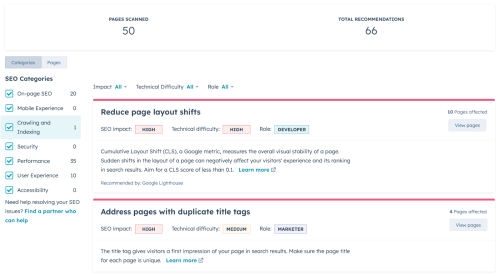
The recommendations tool also labels the overall impact each of these items have on your website’s SEO, the technical difficulty of each recommendation, and who would be best suited to work on a specific recommendation (i.e. “Marketer”, “Developer”). You can also review the recommendations by specific web pages, allowing you to quickly review and make updates to your most important web pages. Overall, the “recommendations” tool is a great way to view the overall SEO health of your websites, and make optimizations where needed!
Performance Tracking via The Analyze Tool
Another great SEO tool is the “Analyze” tool, where you can monitor your website’s performance in search engine rankings. It provides insights into your website’s visibility in search engines, organic traffic to your website, and keyword ranking performance, allowing you to track the impact of your SEO efforts.
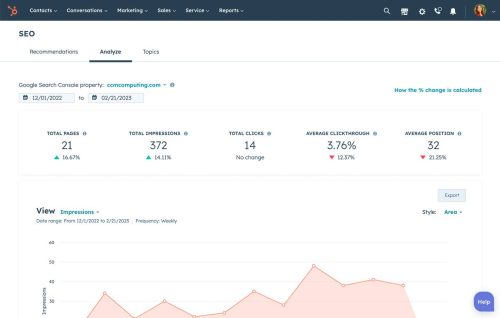
While you can see an overview of your website’s SEO performance you can also narrow down these stats by specific web pages, as well as view which keywords a visitor searched for in the search engine to find that specific page. You can also export these reports and share them with your team for further analysis.
It’s important to note that you’ll first need to create a free Google Search Console account and then connect it to your HubSpot account in order to have data populate under this tab. You can find more information on how to get this integration setup here. Once you have the integration set up, you’ll be able to keep track of your websites’ SEO stats right under HubSpot!
Keyword Research/Topic Research via The Topics Tab
The final tool under the SEO section of HubSpot is under the “Topics” tab, which allows you to research topics, sub-topics, and keywords that match your business’ industry and area of expertise. You can then associate these topic and subtopic keywords to relevant pages on your website, which can help said pages be more accurately indexed by search engines.
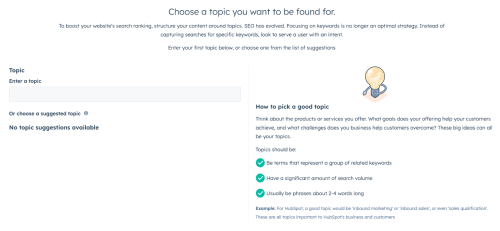
It first starts with deciding what specific topic you want to be found for, which should be associated with the products and services that your business offers. You can either choose from the list of suggested topics that HubSpot generates based on the content of your website, or you can enter a topic yourself. Just remember to follow HubSpot’s recommendations when selecting a topic keyword, which include:
- The topic keyword being a term/terms that represent a group of related keywords
- The topic keyword has a significant amount of search volume within search engines
- The topic keyword should be a phrase about 2-4 words long
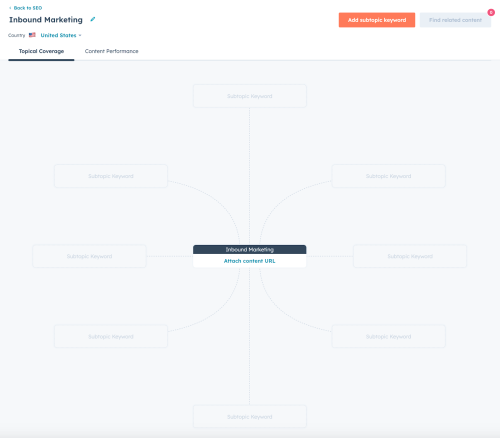
Once you’ve chosen your main topic you can then associate either one of your HubSpot or non-HubSpot pages to this main topic. This page will act as the “pillar page”, a detailed resource page that will cover your topic in further detail through the help of your subtopic-related keywords/web pages that it links back to.
After you’ve associated your pillar page to your main topic, you can then add additional content that supports your main topic/pillar page through content written about your subtopic keywords. These subtopic keywords should be focused on specific search queries that are associated with your main topic. For example, if your main topic is about “Coffee” your subtopic can be about “best way to make coffee” or “how to make coffee at home”.
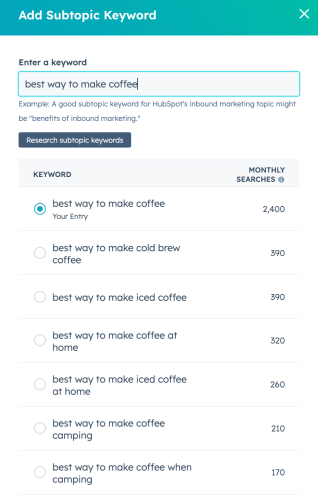
From here you would see a list of different subtopic keywords that are relevant to the search query you entered, along with the number of searches each keyword gets per month via search engines. You’ll want to choose a subtopic keyword that would work best for your subtopic content, and has at least 300 monthly searches.
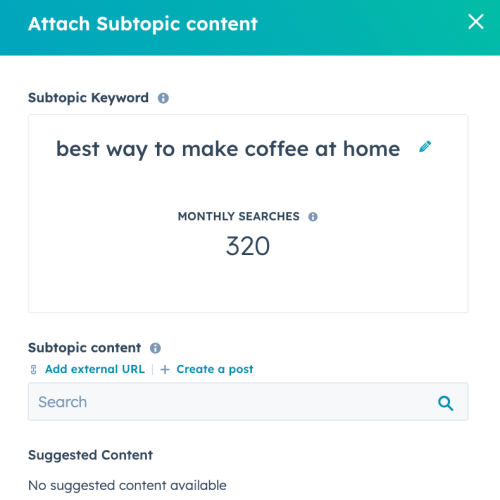
Once you’ve chosen your subtopic keyword, you’ll then attach your subtopic content that is relevant to that specific keyword. If you don’t have that content already created and use HubSpot to create said content, you can quickly get started through the help of HubSpot’s handy Content Assistant Tool! Remember that each subtopic content piece should link back to your pillar page in order to help search engines better understand what your website is about.
Also note that if you have your Google Search Console account already connected to your HubSpot account, you’ll be able to see what your visitors searched for in Google that led them to each specific page over time, which can be used to create and add additional subtopic keywords and content! This data will take some time to populate however, so keep this in mind.
Overall, the importance of implementing SEO best practices throughout your website is critical in ensuring that you have a better chance of ranking higher within search engine results and having potential customers find you. Following the key SEO best practices mentioned above, combined with the support of HubSpot’s SEO tools, can help you get started on your SEO journey!

 Back to blog
Back to blog
